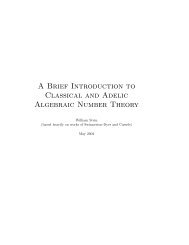COMPUTATIONAL VERIFICATION OF THE BIRCH ... - William Stein
COMPUTATIONAL VERIFICATION OF THE BIRCH ... - William Stein
COMPUTATIONAL VERIFICATION OF THE BIRCH ... - William Stein
Create successful ePaper yourself
Turn your PDF publications into a flip-book with our unique Google optimized e-Paper software.
10 GRIGOROV, JORZA, PATRIKIS, STEIN, AND TARNIT¸ Ǎ-PǍTRAS¸CU<br />
Cha [Cha03, Cha05] extended Kolyvagin’s method to provide better bounds on<br />
X(E/K) in some cases. Let K be a number field, let DK be the discriminant of K,<br />
and let N be the conductor of E, and again assume that the Heegner point yK has<br />
infinite order.<br />
Theorem 3.5 (Cha). If p ∤ DK, p 2 ∤ N, and ρ E,p is irreducible, then<br />
ordp(#X(E/K)) ≤ 2 · ordp([E(K) : ZyK]).<br />
Remark 3.6. As we will see in the proof of Theorem 4.3 below, there is exactly<br />
one curve that satisfies the hypotheses of that theorem, but for which we cannot<br />
use Theorem 3.4 to prove BSD(E, 5) since for that curve ρ E,5 is not surjective.<br />
Fortunately, we can use Cha’s Theorem 3.5 in this case.<br />
Cha’s assumption on the reduction of E at p and assumption that p ∤ DK is<br />
problematic when there is a prime p ≥ 5 of additive reduction or one uses only<br />
one K. This situation does occur in several cases, which motivated us to prove the<br />
following theorem:<br />
Theorem 3.7. Suppose E is a non-CM elliptic curve over Q. Suppose K is a<br />
quadratic imaginary field that satisfies the Heegner hypothesis, that the Heegner<br />
point yK has infinite order, and suppose p is an odd prime such that p ∤ [E(K) /tor :<br />
ZyK], that p ∤ #E ′ (K)tor for all curves E ′ that are Q-isogenous to E, and that<br />
disc(K) is divisible by some odd prime other than p. Then<br />
p ∤ #X(E).<br />
Since the proof of Theorem 3.7 is long, we defer it until Section 5.<br />
Remark 3.8. If in Theorem 3.7, ρ E,p is irreducible, then p ∤ #E ′ (K)tor for all E ′<br />
isogenous to E. This is because the isogeny E → E ′ has degree coprime to p, so<br />
E[p] ∼ = E ′ [p]. Also, since E[p] is irreducible, if E ′ (K) were to contain a p-torsion<br />
point, it would have to contain all of them, a contradiction since µ p ⊂ K (recall<br />
that we exclude Q( √ −3) as a possibility for K).<br />
Theorem 3.9 (Bump-Friedberg-Hoffstein, Murty-Murty, Waldspurger). There are<br />
infinitely many quadratic imaginary extensions K/Q such that K satisfies the Heegner<br />
hypothesis and ords=1 L(E/K) = 1.<br />
Proof. If ords=1L(E, s) = 0, then the papers [MM91] and [BFH90] both imply the<br />
existence of infinitely many K such that yK has infinite order. If ords=1L(E, s) = 1,<br />
then a result of Waldspurger ([Wal85]) applies, as does [BFH90]. <br />
Theorem 3.9 is not used in our computations, but ensures that our procedure for<br />
bounding #X(E), when E has analytic rank ≤ 1, is an algorithm, i.e., it always<br />
terminates with a nontrivial upper bound.<br />
3.2. The Gross-Zagier Formula. We use the Gross-Zagier formula to compute<br />
the index [E(K) : ZyK] without explicitly computing yK.<br />
The modularity theorem of [BCDT01] asserts that there exists a surjective morphism<br />
π : X0(N) → E. Choose π to have minimal degree among all such morphisms.<br />
Let π ∗ (ω) be the pullback of a minimal invariant differential ω on E. Then<br />
π ∗ (ω) = α · f, for some constant α and some normalized cusp form f. By [Edi91,<br />
Prop. 2], we know that α ∈ Z.
















